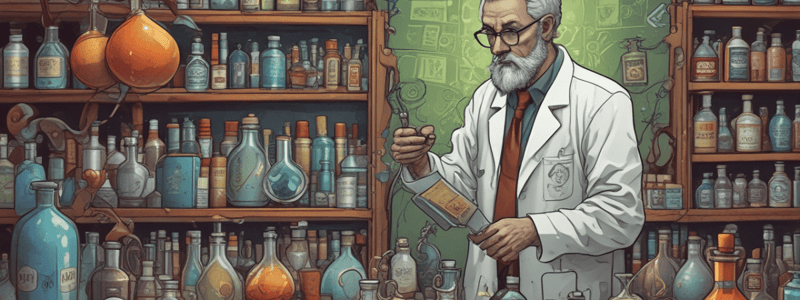Podcast
Questions and Answers
What is the primary focus of the discipline of toxicology?
What is the primary focus of the discipline of toxicology?
- The analysis of xenobiotic poisons in animals
- The development of cleaning solutions and fuels
- The study of medicinal properties of plants
- The recognition of poisonous substances in living systems (correct)
What is the term for a man-made substance or a substance produced by a living organism but not normally found in the body?
What is the term for a man-made substance or a substance produced by a living organism but not normally found in the body?
- Xenobiotic (correct)
- Toxicant
- Venom
- Alkaloid
Where do most poisonings occur?
Where do most poisonings occur?
- In public areas
- At home (correct)
- In the workplace
- In hospitals
Which of the following household products is commonly implicated in poisonings?
Which of the following household products is commonly implicated in poisonings?
What is the term for the poisonous chemical or agent that can cause harm to living systems?
What is the term for the poisonous chemical or agent that can cause harm to living systems?
Who is credited with being the 'father of modern toxicology'?
Who is credited with being the 'father of modern toxicology'?
What is the name of the alkaloid that caused Socrates' death?
What is the name of the alkaloid that caused Socrates' death?
What is the famous quote from Paracelsus that relates to toxicology?
What is the famous quote from Paracelsus that relates to toxicology?
What is the primary concern when a drug is administered beyond its therapeutic dose?
What is the primary concern when a drug is administered beyond its therapeutic dose?
What is the term for the dose of a substance at which no observable effects occur?
What is the term for the dose of a substance at which no observable effects occur?
Which of the following is an example of a sensitive sub-population?
Which of the following is an example of a sensitive sub-population?
What is the primary role of toxicologists in the FDA?
What is the primary role of toxicologists in the FDA?
What type of toxicology is concerned with understanding the mechanisms of toxicity?
What type of toxicology is concerned with understanding the mechanisms of toxicity?
What is the primary goal of descriptive toxicology?
What is the primary goal of descriptive toxicology?
What is the term for the study of the amount of a toxin present in a sample?
What is the term for the study of the amount of a toxin present in a sample?
Which of the following organizations is responsible for setting allowable workplace exposure limits?
Which of the following organizations is responsible for setting allowable workplace exposure limits?
Which branch of toxicology deals with the detection and identification of foreign compounds in biological and related specimens?
Which branch of toxicology deals with the detection and identification of foreign compounds in biological and related specimens?
What is the primary focus of Environmental Toxicology?
What is the primary focus of Environmental Toxicology?
Which branch of toxicology is concerned with making the work environment safe and protecting workers from toxic substances?
Which branch of toxicology is concerned with making the work environment safe and protecting workers from toxic substances?
What is the estimated number of deaths caused by occupational diseases due to industrial chemicals in the US each year?
What is the estimated number of deaths caused by occupational diseases due to industrial chemicals in the US each year?
Which branch of toxicology deals with the effects of toxic substances on humans and the diagnosis and treatment of poisoned patients?
Which branch of toxicology deals with the effects of toxic substances on humans and the diagnosis and treatment of poisoned patients?
What is the primary goal of Mechanistic Toxicology?
What is the primary goal of Mechanistic Toxicology?
Which branch of toxicology deals with the regulation of toxic substances and the establishment of safety guidelines?
Which branch of toxicology deals with the regulation of toxic substances and the establishment of safety guidelines?
What is the focus of Forensic Toxicology?
What is the focus of Forensic Toxicology?
What type of exposure is often associated with acute toxicity?
What type of exposure is often associated with acute toxicity?
Which of the following is an example of systemic toxicity?
Which of the following is an example of systemic toxicity?
What is the primary route of entry for a toxic substance that causes acute inhalation toxicity?
What is the primary route of entry for a toxic substance that causes acute inhalation toxicity?
What is the term used to describe the relationship between a toxic substance, the environment, and the host?
What is the term used to describe the relationship between a toxic substance, the environment, and the host?
What is the primary characteristic of chronic toxicity?
What is the primary characteristic of chronic toxicity?
Which of the following is an example of local toxicity?
Which of the following is an example of local toxicity?
What is the term used to describe the absorption of a toxic substance through the skin?
What is the term used to describe the absorption of a toxic substance through the skin?
Which of the following is NOT a characteristic of the 'host' in the toxic triangle?
Which of the following is NOT a characteristic of the 'host' in the toxic triangle?
What is the approximate lethal dose of sugar for a 160 lb human?
What is the approximate lethal dose of sugar for a 160 lb human?
How many teaspoons of arsenic would be fatal to a human?
How many teaspoons of arsenic would be fatal to a human?
What is the effect of two chemicals with synergistic interactions?
What is the effect of two chemicals with synergistic interactions?
Why is chronic use of aspirin deleterious to the gastric mucosa?
Why is chronic use of aspirin deleterious to the gastric mucosa?
What is the approximate lethal dose of herbicide (2,4-D) for a 160 lb human?
What is the approximate lethal dose of herbicide (2,4-D) for a 160 lb human?
What is the term for the combined effect of two chemicals equal to the sum of the effects of each chemical acting independently?
What is the term for the combined effect of two chemicals equal to the sum of the effects of each chemical acting independently?
Why is vinyl chloride considered a toxic substance?
Why is vinyl chloride considered a toxic substance?
What is the approximate lethal dose of nicotine for a 160 lb human?
What is the approximate lethal dose of nicotine for a 160 lb human?
What is the effect of two chemicals with additive interactions?
What is the effect of two chemicals with additive interactions?
Why is chronic use of metals, such as iron, copper, magnesium, cobalt, and zinc, not toxic to humans?
Why is chronic use of metals, such as iron, copper, magnesium, cobalt, and zinc, not toxic to humans?
Flashcards are hidden until you start studying
Study Notes
Toxicology Basics
- Beyond therapeutic dose, a drug can be toxic, and only the toxic effects are of concern.
- At low doses, there may be no effect (NOEL – no observable effect level), while at levels greater than NOEL, toxicity occurs.
- Individual susceptibility refers to the differences between people, making some more at risk for certain health conditions than others.
- Sensitive sub-populations are more at risk from illness due to exposure than the average healthy person.
Roles of Toxicologists
- Test animals to determine the risk from a particular chemical or agent.
- Study the mechanism of a toxin to determine if or how animal studies may be related to humans.
- Take data and develop regulations for agencies like FDA, EPA, and OSHA.
Classifications of Toxicology
- Descriptive Toxicology: the science of toxicity testing, especially from animal experimentation, to provide information for safety evaluation and regulatory requirements.
- Mechanistic Toxicology: makes observations on how toxic substances cause their effects by identifying and understanding the cellular, biochemical, and molecular basis.
- Analytical Toxicology: the detection, identification, and measurement of foreign compounds (xenobiotics) in biological and related specimens.
Sub-Disciplines of Toxicology
- Applied Toxicology
- Environmental Toxicology: integrates toxicology with sub-disciplines like ecology, wildlife, and aquatic biology, and environmental chemistry.
- Occupational (Industrial) Toxicology: combines occupational medicine and occupational hygiene to protect workers from toxic substances.
- Regulatory Toxicology
- Food Toxicology
- Clinical Toxicology
- Forensic Toxicology
Toxicology Concepts
- Lethal Doses: approximate lethal doses of common chemicals, calculated for a 160 lb human from data on rats.
- Interactions between chemicals: addition (1 + 1 = 2) and synergism (1 + 1 = 5) can affect the outcome of toxicant exposure.
- Xenobiotic: a man-made substance and/or produced by but not normally found in the body.
- Toxicant: a specific poisonous chemical/agent.
- Foreign substances: household products, plants, and certain animals can be poisonous to humans and animals.
History of Toxicology
- 399 BC: death of Socrates by Hemlock
- 1493-1541: Swiss physician Paracelsus, credited with being "the father of modern toxicology"
- 17th century: Romeo and Juliet's reference to poisoning
Types of Toxicity
- Acute: short-term exposure, often one large exposure, immediate damage, and reversible damage.
- Chronic: exposure over a long period, usually small exposures, delayed effects, and irreversible damage.
- Local Toxicity: occurs at the site of application or exposure.
- Systemic Toxicity: requires absorption of the toxicant by the body and distribution via the bloodstream to target organ(s).
Routes of Exposure
- Inhalation: most direct and rapid entrance into the body
- Dermal/Absorption: chemical transfer from the surface of the skin into the body
- Ingestion: poor hygiene or accident
- Puncture/Injection: minimal hazard in most industries
The Toxic Triangle
- Environment: the setting where the toxic substance interacts with humans and the environment.
- Hazard: the characteristics of the toxic substance.
- Host: the characteristics of the human or organism affected by the toxic substance.
Studying That Suits You
Use AI to generate personalized quizzes and flashcards to suit your learning preferences.




